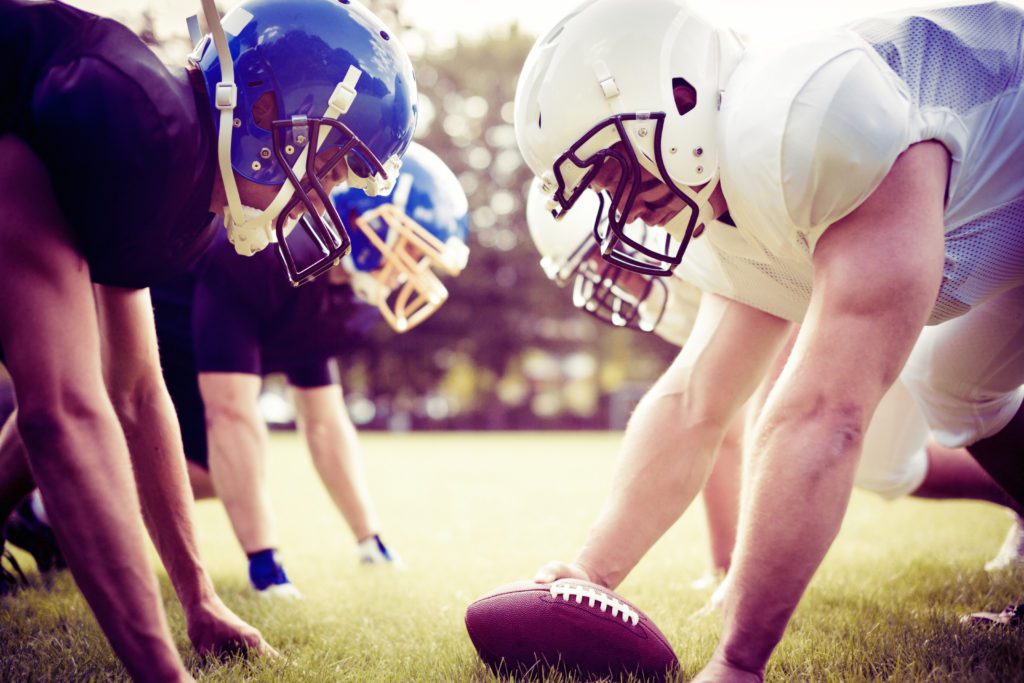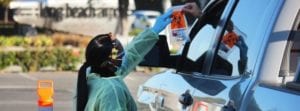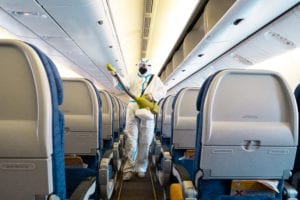By Christopher Reeves, MD
This is part two of a three-part blog series on COVID-19 immunity. If you haven’t read the first entry, read it by clicking here.
You don’t need an encyclopedic knowledge of football to understand that a single offensive lineman can’t be fully responsible for defending his quarterback. Instead, the combined efforts of two tackles, two guards and a center are required to protect the pocket and stifle any sack attempts.
This basic truth of offensive football strategy provides a seasonally fitting metaphor for our efforts to protect ourselves and each other from COVID-19. Just as the quarterback can’t look to one defender for full coverage, we, too, can’t rely on any single preventive tactic against the coronavirus.
Few (if any) COVID-19 preventive measures offer 100% effectiveness on their own. We know the vaccine becomes less potent over time and when pitted against the delta variant. Antibody tests and tests for current infection alike can yield false positive results. Even gold-standard PCR testing has an extremely slim (roughly 1%) margin of error.
Meanwhile, social distancing and face coverings aren’t solely reliable to protect either vaccinated or unvaccinated individuals. As the country continues to reopen and gatherings steadily resume, physical distancing becomes harder to maintain outside the home, and mask recommendations become harder to enforce.
But does the fallibility of any one of these tactics or tools mean it isn’t useful or potentially lifesaving? Of course not!
Allow me to spin that football metaphor a little further. Patrick Mahomes wouldn’t just look at Joe Thuney’s three allowed sacks since 2018 and say, “Well, that’s not 100% success — why don’t you take the bench next game, Joe?” The Kansas City QB would likely get squashed seconds after the first snap.
We shouldn’t position any single preventive measure against COVID-19 as our stand-alone “savior” from the pandemic — not the vaccine, not health mitigation measures, not even the best testing available[https://worksitelabs.com/the-worksite-labs-mission/]. Rather, we should view our strategy as a multi-player defense against the virus, one that equally values and uses each tool in our anti-COVID arsenal.
Vaccines, testing and antibody testing
While we know severe coronavirus infections can result in robust immunity after recovery, we’d never tell anyone to intentionally get COVID-19. The potential consequences are too dire (especially for immunocompromised people), and the vaccine – though not flawless – is very reliable.
Varying success rates aside, the vaccine is the safest way to build up antibodies against the coronavirus. As of late July, it was 94% effective at preventing COVID-related hospitalizations in people under age 75 and 80% effective in those over 75.
Research also shows the vaccine reduces symptoms and recovery time for those who get breakthrough infections. The Food and Drug Administration’s recent full approval of the Pfizer vaccine is just another feather in its cap.
Many Americans remain vaccine-hesitant, even if that number has recently reached a pre-pandemic low. Still, those who choose not to vaccinate should be met where they are – which is where antibody testing can play a key role.
Antibody testing can help vaccine skeptics understand just how vulnerable they are to the virus. Seeing how much immunity a person has built up to the virus from past exposure can help that individual better decide whether a shot in the arm is the right call.
However, antibody testing should not replace testing for current infection, since our bodies can’t build up discernible antibodies until several weeks after infection. COVID-19 testing – especially PCR testing – remains the best way to stay on top of virus spread and gauge community vulnerability.
Social distancing and mask wearing
No diagnostic or scientific tool to prevent or track COVID-19 can eliminate the benefit and necessity of proper, everyday health mitigation measures. From washing and sanitizing your hands to wearing masks and maintaining physical distance, several simple, near-effortless practices can provide protection.
To start, evidence shows mask wearing greatly reduces the exchange of coronavirus-carrying droplets, especially indoors. That’s why the Centers for Disease Control and Prevention (CDC) and the American Academy of Pediatrics recommended universal indoor masking for K-12 schools, as most students are too young to be vaccinated.
But the CDC says face coverings don’t cancel out the need for physical distancing. If you’re indoors around people who aren’t in your household, maintaining a six-foot bubble is how to stay safest — mask or no mask.
Those posters that plastered your elementary school bathroom hold true: hand-washing is among the best ways to keep yourself from getting sick. Washing with soap and warm water for at least 20 seconds — especially following activities with high risk of germ transfer — will never go out of style.
Which of these hygiene practices you observe, as well as when and how often you observe them, is ultimately up to you. If you believe you or others in a certain social situation would be more assured if you wore a mask, maintained distance or both, that’s reason enough to do it. Keeping ourselves and each other comfortable plays into our mid-pandemic mental health — which happens to be a key element of COVID protection.
Self-care, mental health and productive conversations
Across political, religious and other divides, many can agree that COVID-19 has threatened our collective mental health just as much as our physical health over the last 18 months. Most of us only need to look at our lives and those close to us to draw this conclusion.
The data supports that: 41.1% of U.S. adults have consistently reported symptoms of anxiety or depression during COVID, up from 11% before lockdown. 59% of parents find themselves more concerned about their kids’ emotional well-being than before the pandemic.
Such an emotional response to COVID-19 is, unfortunately, to be expected. Previous disasters have historically led to increased reports of distress among affected populations. But — as I’ve discussed in a previous blog post — a healthy mind is a frequently overlooked immune system booster and safeguard against infectious agents like the coronavirus.
While counseling or similar treatments benefit many, making a few adjustments to your daily routine (or simply havinga routine, period) can help you care for your mind. Health experts recommend maintaining social contact however you can, limiting screen time and communicating your feelings to a trusted friend or family member.
Vaccines, testing, health mitigation measures and mental health care. Without any one of them, not only would the COVID-19 case count be higher, but we’d likely be contending with prolonged distance learning for K-12 students, increased mental health crises and other societal setbacks. Every player in our stacked defense plays its own unique, indispensable role in the fight to reclaim our country’s health.
Up next in this series: seldom discussed treatments to explore when your test comes back positive.
Christopher Reeves, MD is chief medical officer of Worksite Labs.




